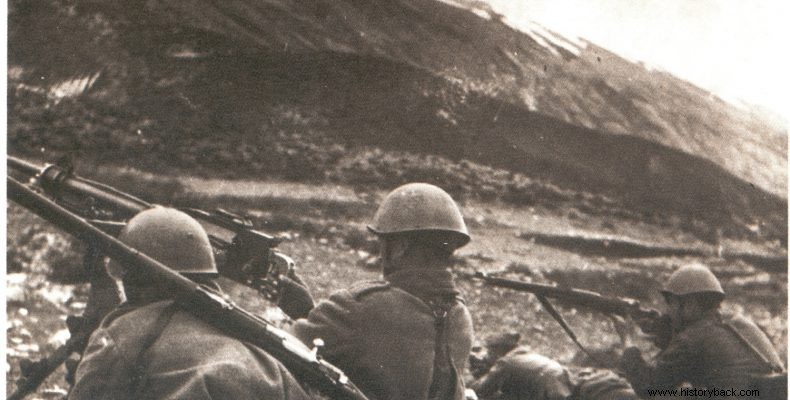
Falled fighting for his country, at 05.30 in the morning of October 28, 1940. Bukouvala soldier George of Dimitriou. That dawn, he found him in the trench, in the chapel of Ai George in Aidonohori, Konitsa. He served in the enlisted 51st Infantry Regiment. Through testimonies, together with Dimitris Malami from Aidonochori, we followed the last steps of the heroic hoplite, who is recorded as one of the first three dead on the front. We reached Burazani and from there, we followed a difficult dirt road and went up to the chapel of Ai-Georgi, where the trenches were. Today, dense vegetation has covered the few remains of the trenches. However, a pilgrim with a lighted candle, at the spot where George Boukouvalas was mortally wounded, gives gratitude and honor to the unknown heroes of the Epic of 1940.
BY MARY ZORA
SOURCE:APE-BE
From Kastritsa to the front line
His fellow villager, Mr. Savvas Siatras, conveys his last words to us in the village. "As my mother used to tell me, on October 27th, returning from the vineyard with the grapes loaded on the donkey, she met George, he was in a hurry and told him.
"-What's up George?
-What will happen to Panagio, with the first bang".
Go full speed for his unit. On the border in Konitsa, in Aidonohori. Giorgos Boukouvalas had already been conscripted since the summer of 1940 and had taken leave to celebrate his father's Saint Dimitrios, but also his one-year wedding anniversary with his wife." The hoplite's words proved to be prophetic.
On the front line in Aidonohori
Arriving in Konitsa, his position is in the trenches at the chapel of Ai George in Aidonohori. The first Italian shells fell there. Giorgos Boukouvalas was mortally wounded. in the trench. The testimony of the elderly Dimitris Boniou, a retired military officer, about that morning in Aidonohori is revealing.
"That dawn found us below Lakies, the hill where the army's defense line had been set up. Some people from the village together with my family were there for protection. They were shelling the Italian cannons from Albanian territory. Shells flew overhead. Everyone was calling for a blackout in the village so they wouldn't see. Turn off the lights. The village was organized My mother had the animals in the forest. We went home and got what we could to get away Tough course. On the uphill of Ai-Lia she threw the bogo that was loaded. He hid him in the forest in a tree. With 4 children in her arms she could not walk. We continued through paths and on the 3rd day we reached Zagorochoria. In Dobra, we met the battalion that was in the village. The forces had been ordered to converge in the rear on the defense line of Katsimitro"
The soldier Georgios Boukouvalas was left in the trench dead
The Italian conqueror entered Aidonohori Konitsa early in the morning. According to the oral testimony of Apostolos Natsis to Georgios Donopoulos, who spoke to APE-MBE, the soldier was hit NW of the Holy Church of Agios Georgios at the location of Mega Logos, in a spot that is now difficult to pass. "Apostolos Natsis, then 10 years old, was coming down from the mountain where he was with other villagers to get some flour and blankets from the house. An Italian soldier, entering the village met him and told him. "There, in the little church, you have a dead one of your own." The boy turned back and found him. Together with his mother, he was buried in the trench. There is a small shrine at the site. Everyone lights a candle there even today, in his memory.
The return to Karitsa
The hoplite of Boukouvala, remained buried in Aidonohori for 7 years. For the inhabitants of the village, as they tell us, he was "their own boy". In 1947 the family moved his bones to Karitsa. "The bells rang mournfully all day. I can't forget the mourning and mourning that day", remembers his sister's daughter, Dionysia Tsiouris, who was a little girl at the time. The father of the hero, Dimitrios Boukouvalas, honoring his memory, added an arch to the bell tower of the church in Karitsa.
The niece of Dionysias Tsiouris commissions the sculptor Thodoros Papagiannis to create the bronze statue of the fallen man on the forehead. In 1998 it was placed in the square of Karitsa and the unveiling took place with all the honors. Giorgos Boukouvalas was a lawyer and was born in 1906 in Karitsa, Ioannina. He studied at his village school. Despite the difficulties and poverty of his family, he succeeded and studied at the Law School of Athens. To make ends meet with his studies, he worked in a technical office in the morning and in a coffee shop in the afternoon. He practiced his profession at the Magistrate's Court of Zitsa. In August 1940, he was drafted due to the events of the period.
